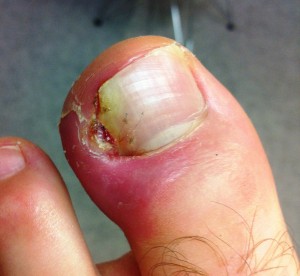There are many procedures that have been developed over the years to address chronic or recurrent ingrown toenails. These range from quite invasive procedures requiring stitches and considerable change to the visual appearance of the toe, to less invasive procedures with minimal post operative pain and less cosmetic effects to the toe.
At The Ingrown Toenail Centre our preferred procedure is a partial nail excision and chemical matrixectomy done under local anaesthetic. This has been shown through research to be the most reliable form of procedure to reduce the risk of recurrence caused by a regrowth of the nail. It is generally very safe, with very minimal pain afterwards, and can be safely performed in an office based clinical setting.
This procedure involves removal of the outside edge of the nail, with the associated area of nail root (matrix), and treatment of the area where the nail root is located with a chemical (phenol) to destroy the cells which are responsible for nail growth. It is done under a local anaesthetic toe block, which means there is no discomfort during or immediately after the procedure, and you can return home directly afterwards. Cosmetically, the nail plate will look slightly narrower once fully healed, and this is usually barely noticeable.
After the procedure, you will be sent home with the toe bandaged and instructions on what to do (pain medications, elevation, rest, keep dry, etc). Typically, your podiatrist will review you within a couple of days and change the dressing, and then given you instructions on self management of the toe (ie changing dressings yourself) over the coming 1-2 weeks. Your podiatrist will then normally review the toe again at that point to make sure it is healing properly, and then follow up with you as necessary after then.
Who is suited to having ingrown toenail surgery?
Most sufferers of chronic ingrown toenails will be suitable for the procedure, however there are some situations where this may not be appropriate. This includes patients with medical conditions where there is poor circulation in the foot, certain medication treatments, or if there are other health problems you podiatrist feels may affect your ability to recover suitably from the procedure.
What are the risks and benefits?
Benefits
The principle benefit of ingrown toenail surgery is to provide a permanent solution to chronic pain, discomfort or infection affecting the toe. Left untreated, chronic ingrown toenails can in some circumstances lead to severe infections, affecting the toe bones and causing a deep infection known as osteomyelitis, which can be very difficult to treat.
Risks
No surgical procedure, no matter how large or small, is without risk.
In general, there are certain complications or adverse outcomes that are common to all surgical procedures. These include, but are not limited to; reaction to the (local) anaesthetic, post operative infection, delayed healing, scarring, recurrence of the original problem, and post operative nerve pain.
Typically, the chance of developing any of these problems with ingrown toenail surgery is very small, and measured at only a few percent of all surgical cases in healthy individuals.
Because of these potential risks, our podiatrists will explain and discuss these issues with you, and ask that you complete a consent form to indicate you are aware of these risks before we undertake care of your problem.


